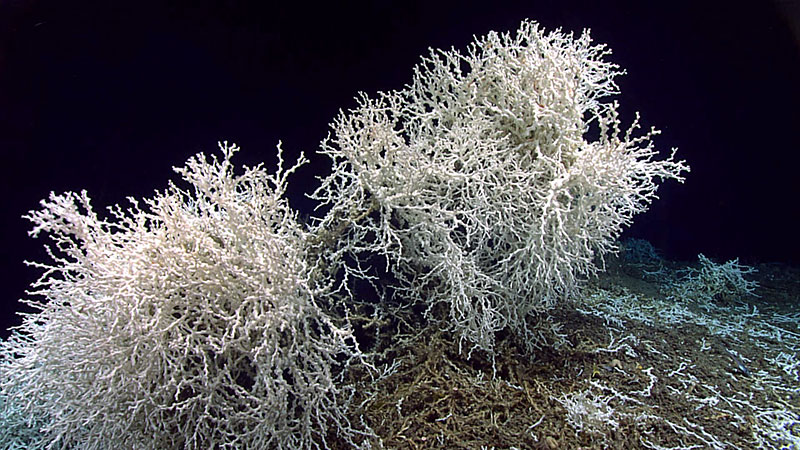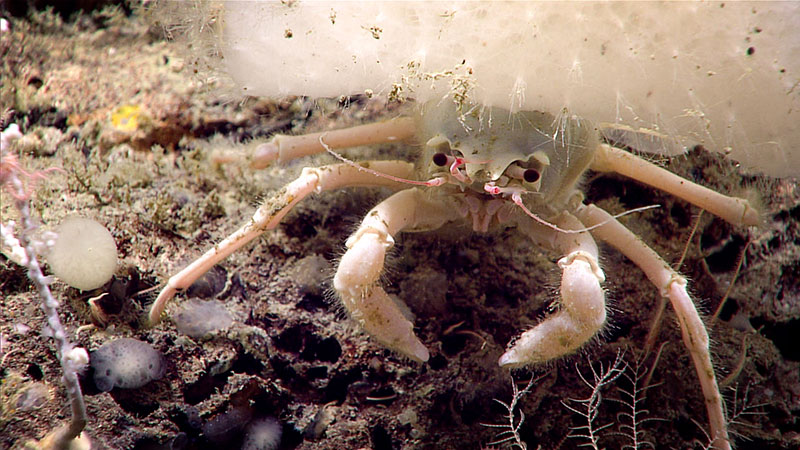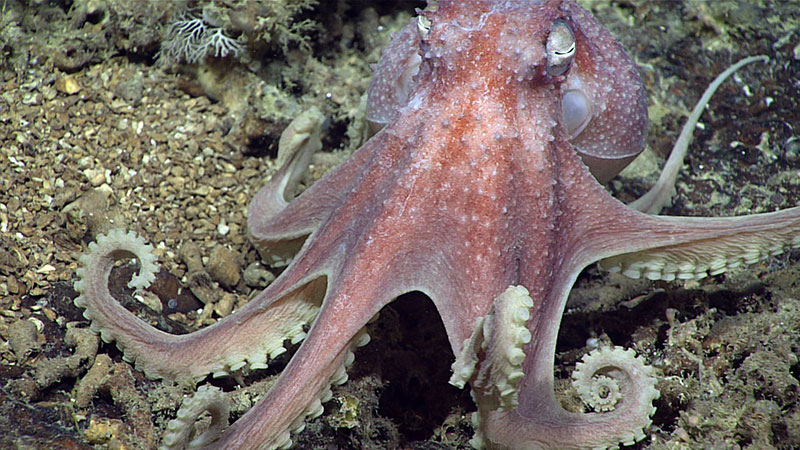
Date: July 1, 2019
Location: Lat: 32.10898457°, Lon: -77.6829949°
Dive Depth Range: 754 - 890 meters (2,474 - 2,920 feet)
Access Dive Summary and ROV Data

A few large thickets of Lophelia pertusa coral were seen growing along the edges of large rock shelf overhangs during Dive 10 of the Windows to the Deep 2019 expedition. Image courtesy of the NOAA Office of Ocean Exploration and Research, Windows to the Deep 2019. Download larger version (jpg, 1.6 MB).
Today we dove at a site nicknamed Richardson “Jellyfish,” due to the fact that it is situated to the northwest of the Richardson Complex, and that a seafloor depression in the area seen in the mapping data resembled the shape of a jellyfish. The feature was first mapped during the Windows to the Deep 2018 expedition, the predecessor of our current mission. The primary objective of this dive was to explore and characterize the habitat for deepwater coral, sponges, and associated fauna.
We started the at a depth of around 890 meters (2,920 feet). Once remotely operated vehicle (ROV) Deep Discoverer reached the seafloor, we saw primarily fine-coarse sediment and coral rubble with very little live coral or sponges. There were high amounts of marine snow in the water column and visibility was relatively low compared to previous dive sites.

This brachyuran crab was seen during Dive 10 of Windows to the Deep 2019 carrying a sponge on its back as added protection from potential predators. Image courtesy of the NOAA Office of Ocean Exploration and Research, Windows to the Deep 2019. Download larger version (jpg, 1.4 MB).

This octopus, nicknamed the warty octopus due to the cartilaginous bumps seen along its body, was imaged during Dive 10 of the Windows to the Deep 2019 expedition. Image courtesy of the NOAA Office of Ocean Exploration and Research, Windows to the Deep 2019. Download larger version (jpg, 1.6 MB).
As the vehicles proceeded up the feature, we observed many fish and a number of large bamboo colonies. Along the way, we also documented a number of large mostly flat rocks that had slightly higher densities of corals and sponges. As Deep Discoverer reached the top of the feature, we saw a few large thickets of Lophelia pertusa and smaller colonies of Enallopsammia profunda growing on the edges of large rock shelf overhangs. The dive concluded on the local high of the feature (around 754 meters; 2,474 feet), which turned out to be flat with low coral and sponge abundance or diversity.
During Dive 10 of the expedition, we explored an area nicknamed Richardson "Jellyfish," due to its location northwest of the Richardson Complex and the fact that it has an unusual shape in the bathymetry data (collected during the Windows to the Deep 2018 expedition). Since 2010, the NOAA Office of Ocean Exploration and Research has been collecting mapping data along the Blake Plateau, Blake Ridge, and Blake Escarpment and has mapped over 65,000 square kilometers (25,097 square miles) of seafloor in this region.
Until recently, much of this area was thought to be flat and largely devoid of features that would make it suitable to support coral communities; however, mapping done via the Okeanos in 2018 and 2019 has revealed a very different picture, showing a seafloor covered with "mound" features. Subsequent exploration using remotely operated vehicles has revealed these mounds are formed by extensive deep-sea coral communities, changing our perspective of the region as we continue to connect the dots to understand the deep. Video courtesy of the NOAA Office of Ocean Exploration and Research, Windows to the Deep 2019. Download larger version (mp4, 89.4 MB).
During the dive, we collected six samples: a bryozoan, two species of coral including a bamboo coral (Isididae) and an octocoral (possibly Swiftia sp.), a swimming polychaete (Tomopteridae), and a sea star (Gilbertaster). A swimming polychaete was a highlight of the dive and a great way to celebrate International Polychaete Day.

Location of Dive 10 on July 1, 2019. Download larger version (jpg, 2.0 MB).

The remotely operated vehicle track for Dive 10, shown as an orange line with a white curtain. Scale is water depth in meters. Download larger version (jpg, 3.1 MB).